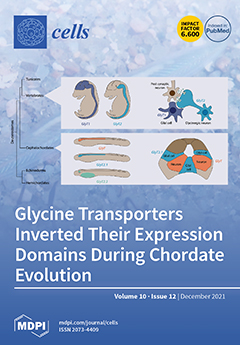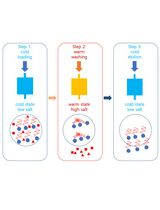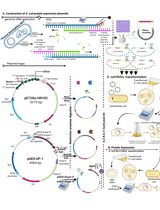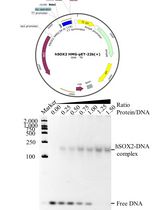- EN - English
- CN - 中文
Expression, Purification, and in vitro Enzyme Activity Assay of a Recombinant Aldehyde Dehydrogenase from Thermus thermophilus, using an Escherichia coli host
使用大肠杆菌宿主的嗜热栖热菌重组醛脱氢酶的表达、纯化和体外酶活性测定
发布: 2022年05月05日第12卷第9期 DOI: 10.21769/BioProtoc.4401 浏览次数: 3303
评审: Alba BlesaAnna M. KöhlerAnonymous reviewer(s)
Abstract
Based on previous in-depth characterisation, aldehyde dehydrogenases (ALDH) are a diverse superfamily of enzymes, in terms of both structure and function, present in all kingdoms of life. They catalyse the oxidation of an aldehyde to carboxylic acid using the cofactor nicotinamide adenine dinucleotide (phosphate) (NAD(P)+), and are often not substrate-specific, but rather have a broad range of associated biological functions, including detoxification and biosynthesis. We studied the structure of ALDHTt from Thermus thermophilus, as well as performed its biochemical characterisation. This allowed for insight into its potential substrates and biological roles.
In this protocol, we describe ALDHTt heterologous expression in E. coli, purification, and activity assay (based on Shortall et al., 2021). ALDHTt was first copurified as a contaminant during caa3-type cytochrome oxidase isolation from T. thermophilus. This recombinant production system was employed for structural and biochemical analysis of wild-type and mutants, and proved efficient, yielding approximately 15–20 mg/L ALDHTt. For purification of the thermophilic his-tagged ALDHTt, heat treatment, immobilized metal affinity chromatography (IMAC), and gel filtration chromatography were used. The enzyme activity assay was performed via UV-Vis spectrophotometry, monitoring the production of reduced nicotinamide adenine dinucleotide (NADH).
Graphical abstract:
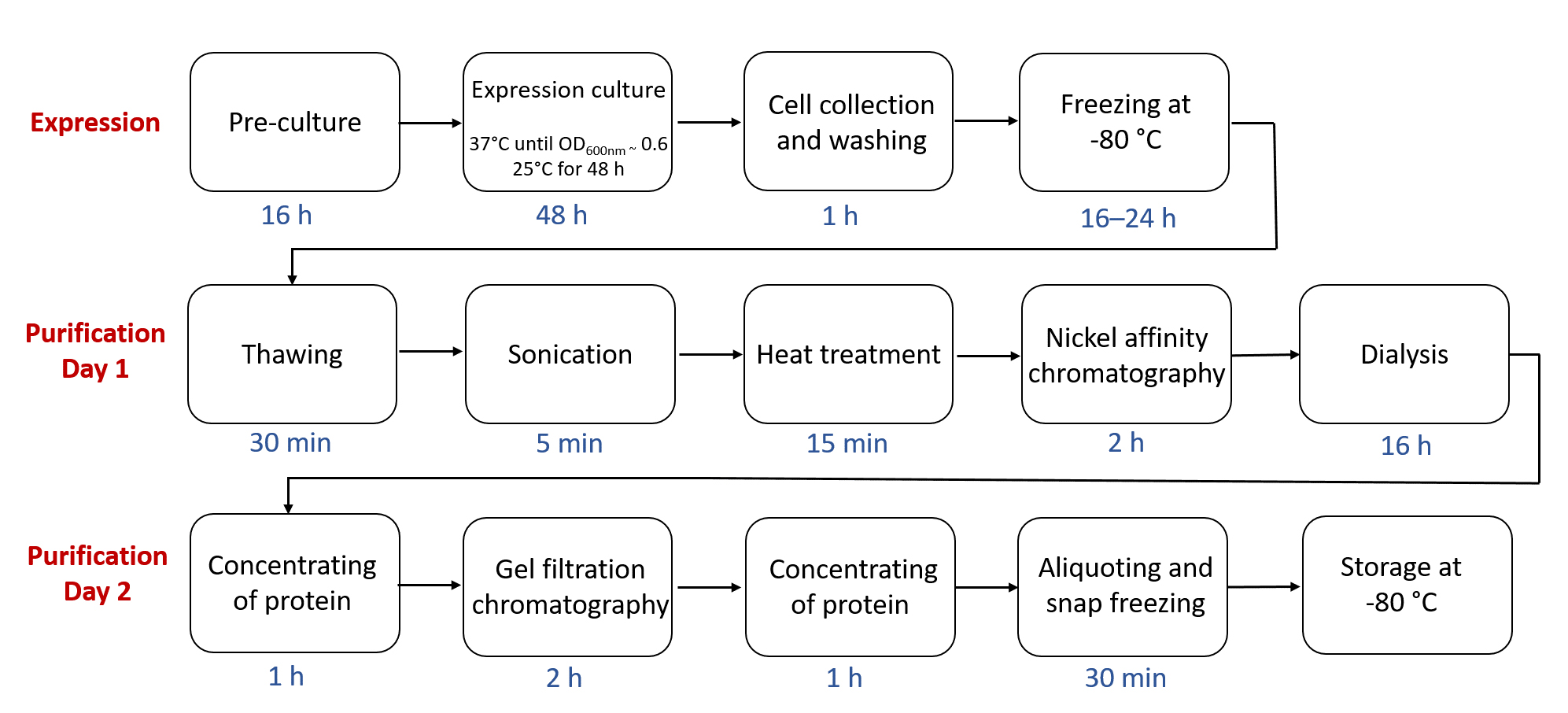
Flow chart outlining the steps in ALDHTt expression and purification, highlighting the approximate time required for each step.
Background
The aldehyde dehydrogenase ALDHTt was first identified and isolated as a contaminant, during cytochrome oxidase caa3-type native purification (Lyons et al., 2012) from Thermus thermophilus, which led to its further investigation. One of the common roles of ALDH family members in mammals is their inherent biosynthesis of retinoic acid assisted by cytochrome oxidases, which shows the possibility of such a role for this enzyme in T. thermophilus, due to the close relation between these two enzymes. Native purification of enzymes from T. thermophilus and other bacterial sources can be cumbersome, difficult, and lengthy, resulting in low protein yields (Soulimane, 2010; Robin et al., 2011). Therefore, recombinant protein production may be an attractive alternative route for the production of proteins for structural characterisation and functional analysis, allowing for high protein purity and yields. In 2018, the ALDHTt was first recombinantly expressed, purified, and its crystal structure determined (Hayes et al., 2018), revealing a novel C-terminal extension in the form of a tail, which contributes to active site regulation, thermostability and the oligomerization mode, aspects not before seen in the ALDH superfamily. The production protocol, employing a 48-h expression culture, heat treatment, immobilized metal affinity chromatography (IMAC) (Figure 1), and gel filtration chromatography, allows for yields of 15–20 mg of highly pure ALDHTt per litre of culture (Figure 2) (Shortall et al., 2021).
ALDHs are often not substrate specific, and can be characterised by their activity for the oxidation of aldehydes using the cofactor nicotinamide adenine dinucleotide (phosphate) (NAD(P)+) to the corresponding carboxylic acid, and nicotinamide adenine dinucleotide (phosphate) hydrate (NAD(P)H). Like other dehydrogenase enzymes, their activity is monitored most commonly via UV-Vis spectrometry for the production of NAD(P)H at 340 nm (Figure 3). ALDHTt can oxidise a range of aldehydes, including aliphatic, aromatic, and cyclics, at elevated temperatures, with the highest catalytic activity achieved with hexanal at 50°C (Shortall et al., 2021).
Conditions detailed here allowed for the production of a pure, soluble, and active form of ALDHTt. The protocol described can also serve as a starting strategy to express and purify similar proteins.
Materials and Reagents
Note: All reagents were stored at room temperature, unless otherwise stated here.
Ice
MilliQ water
Protein Expression
1.5 mL centrifuge tubes (Eppendorf, Sigma-Aldrich, catalog number: EP0030120086-1PAK)
50 mL sterile centrifuge tubes (Corning, Sigma-Aldrich, catalog number: CLS430290)
100 mm Petri dishes (Sigma-Aldrich, catalog number: P5731-500EA)
Cell spreader, sterile (Sigma-Aldrich, catalog number: HS8171A-500EA)
2 L cell culture Erlenmeyer flasks
10 mL serological pipettes, sterile (Sigma-Aldrich, catalog number: CLS4488-50EA)
25 mL serological pipettes, sterile (Sigma-Aldrich, catalog number: CLS4251-200EA)
Aluminium foil
pET22b(+)-ALDHTt (constructed in the lab by Hayes et al. (2018)), store at -20°C
BL21(DE3) chemically competent cells (prepared in the lab), store at -80°C
LB agar (Fisher Scientific, catalog number: BP9724-500)
LB broth (Sigma-Aldrich, catalog number: L3022)
Ampicillin sodium salt (Fisher Scientific, catalog number: A0166), store at 4°C
Tryptone (Fisher Scientific, catalog number: 1278-7099)
Yeast extract (Fisher Scientific, catalog number: 10225203)
Ammonium sulfate ((NH4)2SO4) (Sigma-Aldrich, catalog number: A4418)
Potassium phosphate monobasic (KH2PO4) (Sigma-Aldrich, catalog number: P0662)
Sodium phosphate dibasic (Na2HPO4) (Sigma-Aldrich, catalog number: S9763)
Glycerol (Fisher Scientific, catalog number: BP229-4)
(D)-(+)-Glucose (Sigma-Aldrich, catalog number: G7528)
α-Lactose monohydrate (Sigma-Aldrich, catalog number: L2643)
Magnesium sulfate heptahydrate (MgSO4·7H2O) (Sigma-Aldrich, catalog number: 230391)
ZY Media (see Recipes)
20× NPS (see Recipes)
50× 5052 (see Recipes)
1 M MgSO4 (see Recipes)
ZYP-5052 Auto-induction Media (see Recipes)
Protein Purification
1 L Super-Speed Centrifuge Bottles with Sealing Closure, Nalgene (ThermoFisher, Fisher Scientific, catalog number: 3140-1006)
50 mL Oak Ridge High-Speed Polycarbonate Centrifuge Tubes w/Sealing Cap (ThermoFisher, Fisher Scientific, catalog number: 3138-0050PK)
10 mL serological pipettes, sterile (Sigma-Aldrich, catalog number: CLS4488-50EA)
50 mL sterile centrifuge tubes (Corning, Sigma-Aldrich, catalog number: CLS430290)
0.45 μm syringe filters, nylon (Fisher Scientific, catalog number: 15131499)
20 mL plastic syringes (Fisher Scientific, catalog number: 15889152)
500 mL glass beaker
4 L glass beaker
Magnetic stir bars
Dialysis clips
Dialysis tubing, BiodesignTM Cellulose Dialysis Tubing Roll, 8000 Da MWCO (Fisher Scientific, catalog number: 12707486), store at 4°C
Amicon Ultra-15 centrifugal filters, 50 kDa MWCO (Merck Millipore, Sigma-Aldrich, catalog number: UFC9050)
200 μL PCR tubes (Sigma-Aldrich, catalog number: BR781301)
Liquid nitrogen (LN2)
Lysozyme from chicken egg white (~ 70,000 U/mg) (Sigma-Aldrich, catalog number: 62971), store at 4°C
Deoxyribonuclease I from bovine pancreas (Sigma-Aldrich, catalog number: DN25), store at -20°C
Magnesium chloride (MgCl2) (Sigma-Aldrich, catalog number: M8266)
Trizma base (Sigma-Aldrich, catalog number: T6066)
Hydrochloric acid (HCl) (Fisher Scientific, catalog number: 10053023)
β-mercaptoethanol (Sigma-Aldrich, catalog number: M3148)
Imidazole (Sigma-Aldrich, catalog number: I2399)
Sodium chloride (NaCl) (Sigma-Aldrich, catalog number: S7653)
Chelating Sepharose fast flow (Sigma-Aldrich, catalog number: GE17-0575-01), store at 4–30°C
Ethylenediamine tetraacetic acid (EDTA) (Sigma-Aldrich, catalog number: E9884)
Nickel sulfate hexahydrate (NiSO4·6H2O) (Sigma-Aldrich, catalog number: 227676)
Sodium acetate (C2H3NaO2) (Sigma-Aldrich, catalog number: S2889)
Acetic acid (CH3COOH) (Sigma-Aldrich, catalog number: 695092)
Lysis Buffer (see Recipes)
Buffer A (see Recipes)
Buffer B (see Recipes)
Dialysis Buffer (see Recipes)
Gel Filtration Buffer (see Recipes)
ALDHTt Enzyme Assay
Plastic cuvettes, Fisherbrand Macrocuvettes (Fisher Scientific, catalog number: FB55923)
Hexanal (Sigma-Aldrich, catalog number: 115606)
β-nicotinamide adenine dinucleotide sodium salt (NAD+) (Sigma-Aldrich, catalog number: N0632), store at -20°C
Potassium phosphate monobasic (KH2PO4) (Sigma-Aldrich, catalog number: P0662)
Potassium phosphate dibasic (K2HPO4) (Sigma-Aldrich, catalog number: P3786)
Equipment
Biological safety cabinet
Autoclave
Lab balances
Water bath
Corning® 5 × 7 Inch Top PC-420D Stirring Hot Plate with Digital Displays, 120V/60Hz (Corning, catalog number: 6795-420D)
Shaking incubator (Eppendorf, New Brunswick Scientific Inova 40, Sigma-Aldrich, catalog number: EPM1299-0094)
-80°C freezer, New Brunswisk Scientific Ultra Low Temperature Freezer
Large scale centrifuge (ThermoFisher Scientific Sorvall RC6+ Centrifuge, Fisher Scientific, catalog number: 12121680)
ThermoFisher Scientific, Heraeus Megafuge 16R Centrifuge (ThermoFisher Scientific, Fisher Scientific, catalog number: 75004230)
VWR Microstar12 microcentrifuge (VWR, catalog number: 521-1651)
Probe sonicator (Bandelin Sonoplus HD 2200, catalog number: 2531)
Peristaltic Pump P-1 (Cytivia Life Sciences, catalog number: 18111091)
ÄKTAprime plus (Cytiva Life Sciences)
XK16 chromatography column (Sigma-Aldrich, catalog number: GE28-9889-37)
HiLoad 16/60 superdex 200 pg gel filtration column (Cytiva, Sigma-Aldrich, catalog number: GE28-9893-36)
NanoDropTM ND-1000 (ThermoFisher Scientific, catalog number: ND-ONE-W)
SDS-PAGE apparatus (Biorad Mini-PROTEAN Tetra Cell, catalog number: 1658005EDU)
Cary 60 UV-vis spectrophotometer (Agilent) equipped with a temperature controller (TC-1 temperature controller) (Quantum Northwest, catalog number: TC 1-MAN-2.2)
pH meter, Thermo Scientific Orion 2-star benchtop pH meter (Fisher Scientific, catalog number: Meter Kit 1111001)
Procedure
文章信息
版权信息
© 2022 The Authors; exclusive licensee Bio-protocol LLC.
如何引用
Shortall, K., Magner, E. and Soulimane, T. (2022). Expression, Purification, and in vitro Enzyme Activity Assay of a Recombinant Aldehyde Dehydrogenase from Thermus thermophilus, using an Escherichia coli host. Bio-protocol 12(9): e4401. DOI: 10.21769/BioProtoc.4401.
分类
生物化学 > 蛋白质 > 表达
微生物学 > 异源表达系统 > 大肠杆菌
生物化学 > 蛋白质 > 分离和纯化
您对这篇实验方法有问题吗?
在此处发布您的问题,我们将邀请本文作者来回答。同时,我们会将您的问题发布到Bio-protocol Exchange,以便寻求社区成员的帮助。
Share
Bluesky
X
Copy link


